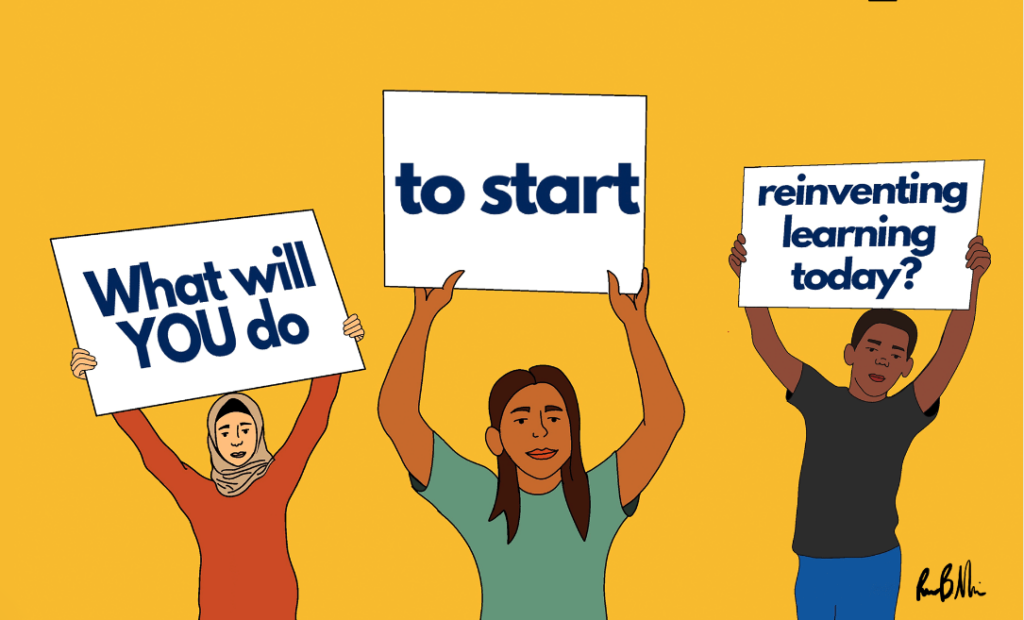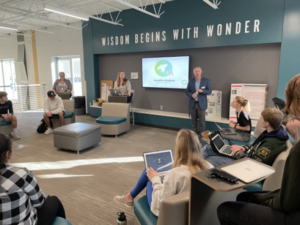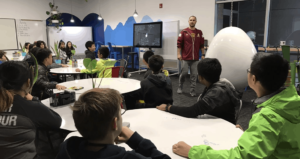4 Principles for Transforming Education Institutions and Systems From the Inside
Key Points
-
To innovate systems from the inside, education systems must be willing to innovate on your core model while building towards the future, create a culture of testing and composting, resist fixed work plans and staffing structures, and get serious about authentic youth participation.
-
The journey towards innovating from the inside can be messy, requires a lot of testing, innovating, and collaborating, and is absolutely worth it to build a more equitable and reinvented future of learning.

By: Michelle Culver
Young people keep telling us that school is boring and irrelevant to their lives and careers, yet schooling has not radically changed for over a century. The pandemic underscored the need to refresh education amidst today’s pace of change and to redesign what, why, how, where and with whom students learn.
But any transformation relies on big systems making space for innovators — and on innovators having faith in the ability of big systems to change. When people with a bent towards innovation consistently hit walls within inflexible institutions and are drawn to launch other ventures, the places where our kids are learning stay outdated. On top of the often-touted entrepreneurs, education needs intrapreneurs, people transforming systems from the inside.
In 2019, I partnered with our CEO, Elisa Villanueva Beard, to launch the Reinvention Lab at Teach For America (TFA) to catalyze the next chapter of TFA’s impact for young people. Since then, the Reinvention Lab’s charge has been “transforming ourselves to radically transform learning,” a concept inspired by Grace Lee Boggs. We ask where the future of learning needs to go, how the system of education needs to evolve and, ultimately, how we put TFA’s assets to work on behalf of creating that future. In collaboration with colleagues across the organization, we help lead TFA’s evolution from the inside to make sure it doesn’t get calcified in its thirty-year approach and design new learning environments with and for young people. One transformation can’t happen without the other.
Even though TFA is serious about doing things differently, the journey has been imperfect and sometimes difficult. From experiences working in public school districts, government agencies, academia, philanthropy and large nonprofits, my teammates and I have compassion for the ways that systems can get stuck.
In the spirit of humility and knowledge sharing with those working to transform our education systems and institutions, here are 4 principles about changing from within that we’ve learned and continue to refine.
Principle 1: Innovate on your core model and build towards the future of learning
TFA’s two-year corps member program is its largest offering. Since 1990, it has attracted young people to teach in low-income communities for at least two years, where they’re employed by local schools and become lifelong leaders in the fight for educational excellence and equity. Like any model created thirty years ago, it requires modernization for the needs of today’s rising generation. This critical work lives alongside nascent projects out of the Reinvention Lab that create new models to address students’ emerging needs. Two current projects for example: designing a summer school experience for students to develop greater agency in exploring post-secondary interests and creating an AI literacy course that college students deliver virtually.
TFA works to simultaneously improve its core model and build towards the future. An in-house innovation team allows a separate and distinct group to focus on new offerings without diluting an organization’s core business. For us, this model allows The Reinvention Lab to experiment in ways that do not put TFA or its existing work at risk.
But we still need to align with the organization’s overall priorities and mission. The Reinvention Lab leaders regularly coordinate with others across the organization even as Lab team members work independently. TFA senior leaders reiterate that all innovative work across the organization matters and is valued, and that the relationship between an in-house innovation team and the rest of the institution is a mutually reciprocal one. Without this, competition over resources or confusion about roles can fester, even among people with shared values and strong professional relationships.
We made missteps around this principle when creating The Reinvention Lab. We took too long to communicate intra-organizationally what was going on behind the scenes, creating anxiety about diffusing organizational focus. We worried about The Reinvention Lab getting scrutinized before we had time to learn deeply from those already working at the intersection of equity and innovation and because it took time to determine how TFA could add unique value to the field. Our concerns meant we didn’t clearly explain how the new team would contribute to TFA’s shared mission. Elliott Witney at ECHO Learning reflected on this same tension from his time running an innovation wing in a Texas school district. He described the ideal as creating a fishbowl around an innovation team to allow collective understanding and transparency without requiring collective input at every step of the way. In hindsight, we should have created this type of transparency and cohesion and done so sooner.
Principle 2: Create a culture of testing and composting
Historically, Teach For America staff feel most successful if they create something quickly, make it big and get it right the first time. I grew up professionally in TFA and in many ways helped create our organizational culture around scale, speed and results. This approach is an asset when it encourages us to be bold and reach as many kids as possible, but it can also result in a culture of perfectionism or risk avoidance.
The Reinvention Lab models dreaming big while starting small. We come up with ideas, test our assumptions through prototypes, refine and iterate. If a project is impactful, we pass it along to our friends in other areas of the organization who are better poised to take the idea to scale. If the data shows we’re on the wrong track, the time was not wasted because we didn’t invest in an expensive program that wouldn’t have made a significant impact.
Moreover, we capture what we’ve learned to inform future projects. We call this process composting, an intentionally organic metaphor. Composting is a way to invest projects we’ve decided not to pursue back into a nutrient-rich soil that can grow into related or different ideas. For example, we observed that a number of our urban and rural district partners began moving to a 4-day school week after the pandemic, partly because of a growing teacher shortage. At the Reinvention Lab, we asked ourselves: If this trend continues, could TFA build an offering for the 5th day? Exploratory research showed that such a program, while promising for young people, would not have been financially viable. Starting small paid off and kept us from building out an entire new initiative that we could not sustain. We composted this idea, and it has influenced our work around reinventing summer school, another potential way to bring innovative models to young people during less regulated learning time.
In a culture of perfectionism, no one wants to “fail.” But if low-stakes prototypes prove assumptions wrong, failing is a win. It’s a responsible way to ensure high-quality experiences for participants and steward an organization’s resources before making huge investments. Adults need space to practice nimbleness and flexibility, skills that young people need too.
The practice of composting is slowly spreading across TFA and helping the organization focus on the places where real breakthroughs and transformations are possible. Our ultimate hope is that we successfully build new offerings that advance the future of learning and become part of TFA’s fabric.
Principle 3: Resist fixed work plans and staffing structures
The culture of testing from Principle 3 requires a new pace of work and a different staffing model. Instead of starting with a predetermined outcome and operating on fixed annual planning cycles, The Reinvention Lab functions in trimester cycles. We set four-month goals, sort ourselves into project teams, plan ahead two weeks at a time and use emerging data to influence what we do next. In between trimesters, we reorganize teams and projects as needed.
More traditional backward planning makes sense in other parts of the organization. When refining an existing program or increasing efficiency, a more linear, annual approach is preferable. The outcome and capacity required are largely known. When you’re trying to create something that does not yet exist, it’s impossible to predict what you’ll need and when.
This style of working runs counter to the common approach in education. School principals and teachers are year-long fixed roles. The plan is linear: students need to master math or English Language Arts content by the end of the school year. Education organizations tend to mirror that linear approach: annual goals, fixed teams, fixed staffing.
Despite our best intentions, The Reinvention Lab found ourselves slipping back into static positions. We continually remind ourselves that our jobs can and often do change, even when that ambiguity is hard to hold. We view the regular evolution of our jobs as an asset and an opportunity to grow. Staffing flexibility also means we can bring in outside people for a broader range of expertise. A number of contractors join our small full-time team to work on specific projects, bringing technical expertise that would be too expensive to hire full time.
In doing so, we’ve brought new vantage points to the work. Because we believe the future of learning needs to expand beyond current school buildings, we value expertise from the edtech sector and from museum, after-school and homeschool settings. We’re betting on the benefit of diversity and different world views, even if doing so means we may bump up against differences in values, working styles, and assumptions. Harnessing a combination of perspectives feels critical to getting something different while making sure it is relevant at TFA.
Principle 4: Get serious about authentic youth participation
There is no effective path forward in education without the earnest involvement of young people. Organizations need to move beyond box-checking surveys and focus groups to thoughtfully engage and uplift the leadership of young people. At The Reinvention Lab, we’ve learned that this is more difficult than anticipated, but essential — having young people at the table has in fact changed the outcome in healthy and unexpected ways.
When we created the Enduring Ideas Fellowship after the pandemic hit, we included youth fellows on the Enduring Ideas Award grantmaking process. Young people comprised 50% of the decision-making body and joined adults to distribute $1.5m to community-based efforts. Time and time again, the group funded efforts that adults alone wouldn’t have funded, a testament to what can happen through participatory decision-making.
Under Malliron Hodge’s leadership, we moved from listening and sharing decision-making to actually co-building. We’ve done this in several different ways, including embedding youth as part-time staff on all projects. Even with our commitment to youth-adult co-creation, putting these values into action has been harder than we expected. Much like the importance of affinity groups, young people need and deserve their own space in addition to time with adult colleagues. Yet students have full school schedules during traditional business hours. If they miss a project team meeting for The Reinvention Lab, it can be difficult to disrupt traditional power dynamics that default to adult decision-making. We’re still figuring out how to maximize the unique assets and participation of young staff by defining what we do as a full team and what we can take on in smaller groups.
Young people are the most impacted yet least engaged stakeholders in education. If the education field doesn’t start sharing power with young people, a small set of largely white adults will continue to make decisions that impact young people and communities of color.
TFA envisions a world in which young people participate in joy-filled, affirming and relevant learning experiences and are prepared to thrive in and shape the future. This world won’t create itself. To unlock and shift our education systems, adults need opportunities to be creative, agile and work in new ways, ways that mirror the responsive learning environments young people have long been demanding. The work of transforming and re-structuring institutions from the inside is never easy and never finished. The transformation of The Reinvention Lab, Teach For America and the nation’s public school system are all works in progress. But each is necessary, interconnected, urgent and possible.
Michelle Culver is the Founder of The Reinvention Lab powered by Teach For America.







0 Comments
Leave a Comment
Your email address will not be published. All fields are required.